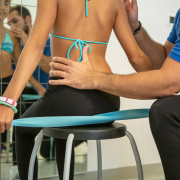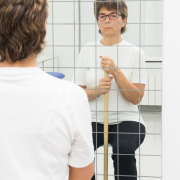Scoliosis: why choose rehabilitation treatment?
I have scoliosis. What should I do? Do I absolutely have to follow a treatment, or is there no point? Will I need to be operated on? These are questions we often get asked by patients who have been diagnosed with scoliosis.
Therapeutic approaches to scoliosis fall into two categories: surgical treatment, indicated only in a limited number of cases, and conservative treatment, which we prefer to call rehabilitation treatment. This latter category comprises different approaches, which are based on the severity of scoliosis.
First of all, there is simple clinical observation (for very mild cases), then treatment based on specific self-correction exercises (for mild scoliosis), and finally bracing (for the treatment of moderate forms). The braces used can be elastic, rigid or super-rigid. The choice of brace type and the number of prescribed brace-wearing hours (treatment dose) are always determined by two key factors: the severity of the curve(s) and the risk of worsening.
Even though surgical techniques have improved enormously over the years, surgery for scoliosis always entails vertebral fusion, and thus a complete loss of mobility (function) of the section of the spine involved, which is transformed into a single bone. It is the most difficult surgery in orthopaedics (apart from surgery for severe poly-trauma), and naturally it carries all the risks that derive from the fact that the spine encases and protects the spinal cord, which contains all the connections between the brain and the lower limbs.
Rehabilitation treatment, therefore, must always be considered the first-choice treatment for scoliosis. This even applies to “surgical curves” (i.e., those with a Cobb angle greater than 45°–50°), if no attempt has ever been made to correct them through full-time bracing and specific exercises (1). In short, surgical treatment is used only when rehabilitation treatment has failed.
What are we aiming to achieve through rehabilitation treatment?
Basically, we are aiming to obtain a back that is not only strong and efficient but also aesthetically pleasing. This is, indeed, one of our main objectives, given that a person’s quality of life is strongly influenced by how they see themselves physically. Therefore, a brace needs to be built in such a way as to reduce the external deformity as well as the magnitude (i.e., the Cobb degrees) of the curve(s). In this regard, it is very important to underline the importance of preventing scoliosis from worsening, especially in puberty when it is at the greatest risk of doing so. Reducing the Cobb degrees of a scoliotic curve is always an objective, but given that scoliosis in puberty almost always worsens unless it is treated properly, simply blocking the evolution of the condition must, in itself, be considered a successful result.
Through rehabilitation treatment, we also try to prevent the onset of back pain in adulthood. To this end, as well as treating any pain that occurs in childhood and adolescence, we also do our best to preserve, as far as possible, the physiological curves present in the sagittal plane. Several studies have shown that back pain in adults with scoliosis is highly correlated with abnormalities in the sagittal plane, even more so than with scoliotic curve magnitude (2). And unfortunately, over the years, scoliosis that exceeds certain levels tends to progressively worsen; as a result, for purely mechanical reasons, the trunk progressively falls forwards.
Finally, rehabilitation treatment aims to prevent the respiratory system problems that can arise due to progressive deformation of the rib cage in the presence of a severe thoracic curve.
All these objectives were extensively discussed, and identified as therapeutic priorities, by international experts from the International Society on Scoliosis Orthopaedic and Rehabilitation Treatment (SOSORT) during the drafting of the SOSORT Guidelines (3).
(1) Lusini M, Donzelli S, Minnella S, Zaina F, Negrini S. Brace treatment is effective in idiopathic scoliosis over 45°: an observational prospective cohort controlled study. Spine J. 2014 Sep 1;14(9):1951-6. doi: 10.1016/j.spinee.2013.11.040. Epub 2013 Dec 1. PMID: 24295798.
(2) Diebo BG, Shah NV, Boachie-Adjei O, Zhu F, Rothenfluh DA, Paulino CB, Schwab FJ, Lafage V. Adult spinal deformity. Lancet. 2019 Jul 13;394(10193):160-172. doi: 10.1016/S0140-6736(19)31125-0. Epub 2019 Jul 11. PMID: 31305254.
(3) Negrini S, Donzelli S, Aulisa AG, Czaprowski D, Schreiber S, de Mauroy JC, Diers H, Grivas TB, Knott P, Kotwicki T, Lebel A, Marti C, Maruyama T, O’Brien J, Price N, Parent E, Rigo M, Romano M, Stikeleather L, Wynne J, Zaina F. 2016 SOSORT guidelines: orthopaedic and rehabilitation treatment of idiopathic scoliosis during growth. Scoliosis Spinal Disord. 2018 Jan 10;13:3. doi: 10.1186/s13013-017-0145-8. PMID: 29435499; PMCID: PMC5795289.


